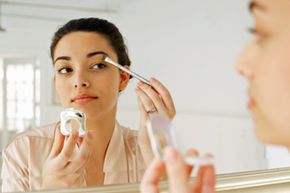“
Light reflecting makeup is really pretty neat. When you compare it to conventional makeup, it’s like using clever camouflage instead of a blanket to conceal less than perfect skin. They both do the job, but light reflecting makeup blends somewhat better because it uses tiny mineral particles like crushed pearls, titanium dioxide and mica to reflect light away from dark spots, wrinkles and blemishes. Think of all those particles as thousands of minute, flesh-colored prisms that fill wrinkles and mirror the appearance of your undamaged skin across imperfections (we’ve all got them), making them invisible — or at least much less noticeable. If this sounds like science fiction, don’t be fooled. The movie "Predator" notwithstanding, this stuff really works. You can find light reflecting technology in lots of cosmetic products on the market these days, like foundation, pressed powder, concealer, hand lotion, primers and moisturizers.
Light reflecting products, also called light diffusers, perform their wizardry using crushed or micronized minerals. Micronized mineral preparations are milled or ground very fine to provide more subtle coverage than crushed mineral products. Both will reflect light well. The results have been compared to the look of a softening filter on a camera lens for reducing the appearance of fine lines and wrinkles, dark under eye circles, blemishes, age spots, freckles and redness.
Light reflecting makeup gives skin an even, luminous finish that looks natural and vibrant without appearing shiny or greasy. It may also contain fewer preservatives, fillers and fragrances than the cosmetics you’re used to. Follow us to the next page for tips on how to apply light reflecting mineral makeup.
Preparing Your Skin for Light Reflecting Makeup
For the best results, choose the right foundation by applying a small amount of the product you have in mind along your jawline. Blend it in and wait a couple of minutes. It should disappear completely, leaving a smooth, even finish behind. If it looks chalky, the shade is too light. If it looks ruddy or orangey, the shade is too dark.
Once you’ve chosen a light reflecting makeup:
- Clean — Prepare your face by cleansing it thoroughly.
- Tone — Apply a toner (if you use one) to remove excess oil, tighten your pores and adjust your skin’s pH balance.
- Moisturize — Add moisturizer in smooth even strokes. Use moisturizing products that contain an SPF 15 (at least) broad-spectrum sunscreen. Don’t make the mistake of adding foundation too soon. Let your skin absorb the moisturizer completely. The emollients and humectants in the formulation you’re using will help protect your skin and keep it hydrated. They will also work with the foundation to reduce drag and allow you to apply the product more easily.
- Add primer — For the smoothest application, invest in a skin primer product and add it after your moisturizer. It works with your foundation to ensure even coverage and consistent skin tone. This may seem like an unnecessary step, but if you have problems with age spots or redness, it’s extra insurance.
Applying Light Reflecting Makeup
Now that your skin is cleaned, toned, moisturized and primed, it’s time to apply foundation.
For liquid foundation — Use a sponge applicator instead of your fingers. It will give you better coverage and a more professional looking result. We like latex sponges, but there are a number of materials on the market you can try, so use what feels comfortable. Moisten the sponge slightly before each use to keep it from absorbing too much foundation.
For powder foundation — Use a large, soft bristle brush like a Kabuki brush as an applicator. A brush will make it easier to manipulate and blend the powder with less effort. Be sure to tap off excess powder before you begin applying makeup. It’s easier to add more than it is to remove it if you apply too much.
After choosing an applicator, follow these steps:
- Add foundation — Place a small amount of foundation on a cloth, the back of your hand, the bottle’s cap or another surface, and use it as your palette. Load the applicator with a little foundation, and add small dots of foundation to your forehead, chin and cheeks.
- Sweep and smooth –– Smooth and blend the foundation in place from dot to dot working from the outside (jaw and temples) in toward your eyes and nose. A little product goes a long way. Swirl the sponge or brush over your cheeks, and use a sweeping motion on your forehead and chin.
- Refine –– Finish with a patting or taping motion to the delicate areas under your eyes and around your nose. Your finger can be effective at smudging and blending foundation into these delicate areas, too. With either a liquid or a powder foundation, you can also use a fan brush to refine and polish your look.
Use Sunscreen
The Skin Cancer Foundation recommends that you use a broad spectrum sunscreen in your moisturizer that protects you from both UVA and UVB rays.
Lots More Information
Related Articles
- Cosmetics: What Women Buy, How They Buy It and Why
- Summer Makeup Essentials
- 5 Makeup Application Tools You Need
- Makeup for Women of Color
- 5 Secrets to Covering Scars With Makeup
- How to Organize Makeup
Sources
- Acne Magazine. "How Light Reflecting Makeup Can Help Diminish the Appearance of Acne." 11/3/10. (8/13/12). http://www.acnemagazine.com/how-light-reflecting-makeup-can-help-diminish-the-appearance-of-acne/
- Almay. "Application Tips – Foundation." (8/13/12). http://www.almay.com/makeup-tips/makeup-solutions/application-tips.aspx?utm_source=google&utm_medium=cpc&utm_term=how%20to%20apply%20foundation&utm_campaign=Unbranded+Foundation+-+E&utm_content=sCkzGLlbf_pcrid_22695504705
- Cosmopolitan. "How to hide hungover skin." 12/2011. (8/13/12). http://cosmo.intoday.in/story/how-to-hide-hungover-skin/1/8505.html
- Daily Mail. "Cosmetics that take away the years." (8/13/12). http://www.dailymail.co.uk/femail/article-4463/Cosmetics-away-years.html
- Irvine, Susan. "Beauty notebook: light-reflecting make-up." Telegraph UK. 2/28/02. (8/13/12). http://fashion.telegraph.co.uk/news-features/TMG4794579/Beauty-notebook-light-reflecting-make-up.html
- Kerr, Alison. "How to Choose Foundation." Channel 4. 1/11/11. (8/13/12). http://www.channel4.com/4beauty/make-up-skin-care/make-up/make-up-ideas/guide-to-foundation
- Matlin, Jessica. "Problems with Foundation: The Puzzle Solved." Oprah. 9/2007. (8/13/12). http://www.oprah.com/style/How-to-Choose-and-Use-the-Right-Foundation/2
- Skin Cancer Foundation. "Saving Face with Mineral Makeup." (8/13/12). http://www.skincancer.org/media-and-press/Press-Release-2008/saving-face-with-mineral-makeup
- Wheeldon, Ceri . "Best Anti-ageing Make-up Tips." Fab After Fifty. (8/13/12). http://www.fabafterfifty.co.uk/2011/01/24/best-anti-ageing-make-up-tips/